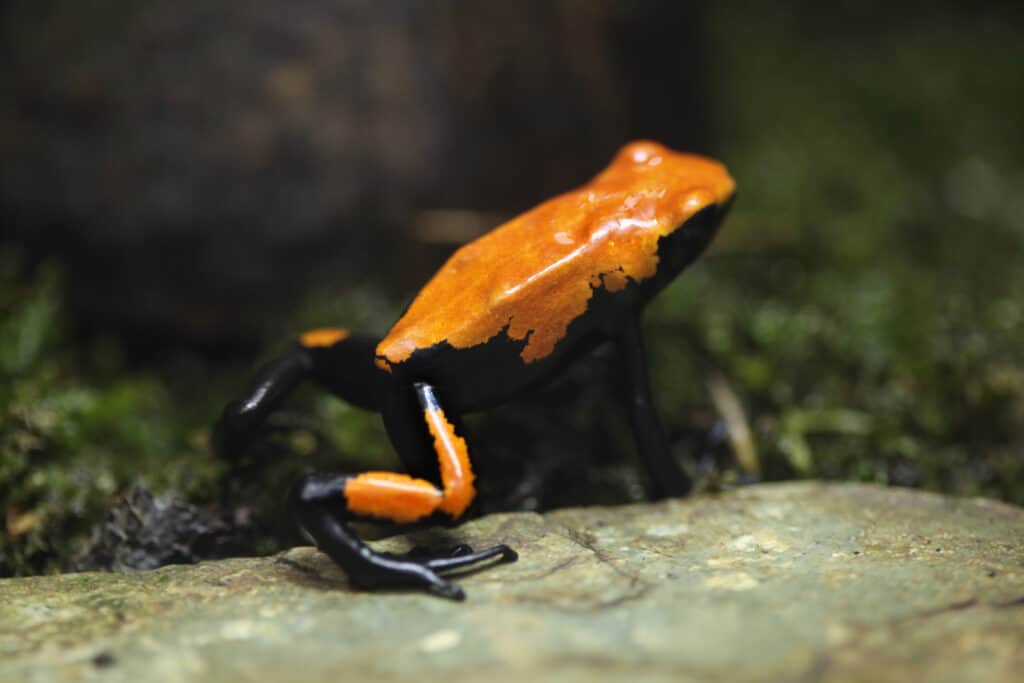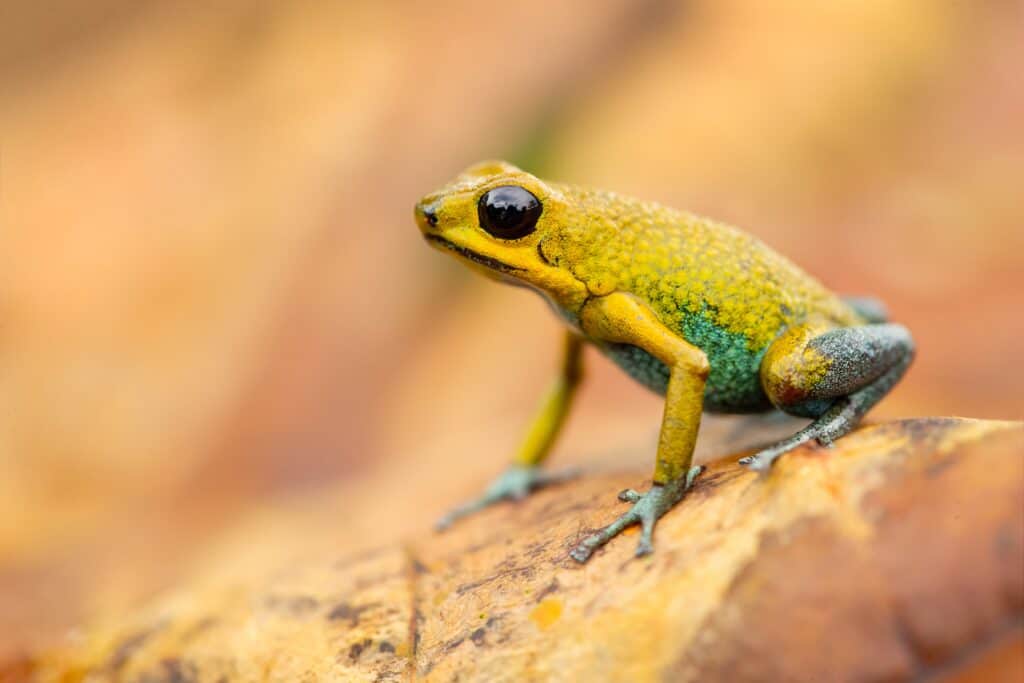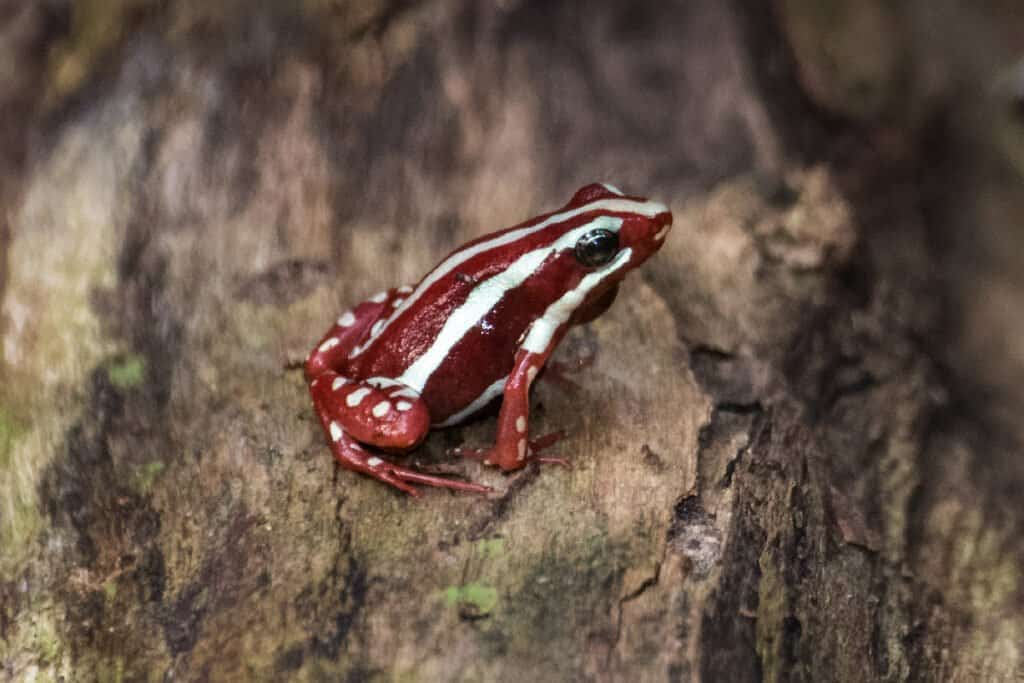What is the most exhilarating thought that enters your mind when you think of lush tropical rainforests? Adventure, of course! Exploring captivating views and hearing the chatter of wildlife sounds heavenly… doesn’t it? But within these dense rainforests lies a deadly fear factor. Creatures often heard and not seen…So let’s talk about them. The 5 most deadly frogs in the world.

These small, multi-colored frogs all have one thing in common…toxic poison. The deadliest frogs in the world can be found in Central and South America. These regions provide an ideal living habitat where the rainforest has humid temperatures and rain all year round.
These frogs have made the rainforest their home because they have porous skin, making them reliant on moisture so they can maintain their slimy skin texture.
These amphibians are so unique as their bright skin color secretes a toxic poison that is harmful to humans and predators. This is their way of saying keep your distance and leave them alone.
These 5 frogs are called:
- The golden poison dart frog
- The dyeing dart frog
- The splashback poison frog
- The granular poison frog
- The phantasmal poison frog
The Golden Poison Dart Frog Is The Deadliest Frog In The World

The golden
poison dart frog
is known as the deadliest frog in the world.
©Thorsten Spoerlein/Shutterstock.com
The golden poison dart frog is known as the deadliest frog in the world. They can be found near the Pacific Coast of Columbia. As the golden frog starts to mature, its skin tone is made up of a light green, yellow, or orange tone with an added stripe pattern that covers the shape of the frog’s body.
Surprisingly as they enter adulthood, the coloration of the skin tone will change to a single dark color, and their unique pattern markings will disappear.
Because their skin releases an alkaloid poison, it is known to cause muscle paralysis, making them deadly and dangerous. These frogs were used by native tribesmen to coat their arrow blowpipes with the frog’s lethal poison.
This made hunting easier for the tribe members as the poison assisted them with catching and paralyzing wildlife. These frogs like to stay close to the ground and prey on species such as
They like to hide on the ground to camouflage their vibrant colors. Their long and elastic tongue makes hunting for food an easy task, especially when feeling like a quick snack.
The Dyeing Poison Frog

This frog got their name from tribesmen who used the frogs to color parrot feathers from green to red.
©iStock.com/Frank Cornelissen
This frog species can be found in parts of Venezuela and Brazil. They got their name from tribesmen who used the frogs to color parrot feathers from green to red.
Their skin tone is made up of a combination of three colors. First, the main part of the body has a yellow base that fades into dark blue-colored legs. Then finally, their markings are black and visible on the yellow base of the skin tone.
The poison secreted when they feel threatened is extremely toxic, especially when coming into contact with your skin. The consequences of touching the dying poison frog will cause swelling and muscular paralysis will set in.
They love to hang out in the trees as there is an abundance of small spiders, ants, and termites, allowing them easy access to prey.
The Splashback Poison Frog

Splash-backed frogs are one of the most deadly frogs in the world.
©Vladimir Wrangel/Shutterstock.com
The splashback poison frog is found in Brazil’s Northern and North Eastern areas. These frogs are medium in size and display a variety of colors.
Their name begins with splashback due to their bright metallic pattern that is exposed on the back part of the body representing a splash-like shape.
The vivid colors present a plain black base on the frog’s body, added with either an orange, yellow or red splash of color on top of the black base. Each frog’s color determines what location it will be discovered in.
They are one of the most deadly frogs in the world because when infected with the splashbacks poison, people have experienced the following symptoms:
- Muscle weakness
- Drooling
- Dizziness
- Paralysis
- Effects respiratory muscles
The Granular Poison Frog

Due to threats such as deforestation, the granular poison frog conservation status is listed as Endangered.
©Milan Zygmunt/Shutterstock.com
The granular poison frog is found in Costa Rica and Panama. Their coloring represents a bright orange tone to the upper part of the body. A mixture of blue and green tones appears on the lower end of the belly and legs.
The skin texture has a bumpy and granular appearance, making them different in color and skin texture compared to the other poisonous frogs.
During the rainy season, the male frog creates an area close to a stream known as its mating site. The female uses this area to lay her eggs.
During this time, males are on high alert, becoming aggressive and fending off other male frogs as they can possibly attract a potential mate. Unfortunately, due to threats such as deforestation, their conservation status is listed as Endangered.
Their poisonous skin is so toxic it can cause severe paralyzes in humans, but it is not fatal.
The Phantasmal Poison Frog

Phantasmal poison frogs like to live either on or near banana and cacao plantations.
©iStock.com/Thorsten Spoerlein
The phantasmal poison frog is located in Ecuador near South America, where its skin is red in color, with a flair of longitudinal white stripes running down the frog’s body. These frogs like to live either on or near banana and cacao plantations, where they lay low to the ground and can prey and consume on little creatures such as:
- Fruit flies
- Woodlice
- Weevils
These amphibians are highly endangered, and numbers are declining due to natural predators, farming, and the illegal pet trade.
The phantasmal poison frog produces a critical toxin called epibatidine, which attacks the nervous system, causing paralysis, and sometimes death, even in tiny doses.
When Planning Your Next Adventure Beware Of The Deadly Frogs
If you are daring enough to enter the Amazon to view these mesmerizing frogs, be sure to go with a guide. While their colors might be enticing, they are extremely dangerous.
So, tread lightly when walking into this dense jungle, as they could be hiding on the ground or up above your head.
Summary Of The 5 Most Deadly Frogs In The World
| Rank | Frog | Location |
|---|---|---|
| 1 | Golden Poison Dart Frog | Pacific Coast of Columbia |
| 2 | Dyeing Poison Frog | parts of Venezuela and Brazil |
| 3 | Splashback Poison Frog | Brazil’s Northern and North Eastern areas |
| 4 | Granular Poison Frog | Costa Rica and Panama |
| 5 | Phantasmal Poison Frog | Ecuador |
The photo featured at the top of this post is © Frank Cornelissen/Shutterstock.com
Sources
- Wikipedia, Available here: https://en.wikipedia.org/wiki/Golden_poison_frog
- National Geographic, Available here: https://www.nationalgeographic.com/animals/amphibians/facts/golden-poison-frog
- Animnals.Mom, Available here: https://animals.mom.com/top-five-poisonous-frogs-2811.html
FAQs (Frequently Asked Questions)
What's the deadliest frog on Earth?
The golden poison dart frog is known as the most poisonous frog in the world.
Where is the golden poison frog found?
They can be found near the Pacific Coast of Columbia.
What does a golden poison frog look like?
Its skin tone is made up of a light green, yellow, or orange tone with an added stripe pattern that covers the shape of the frog’s body.
Thank you for reading! Have some feedback for us? Contact the AZ Animals editorial team.






